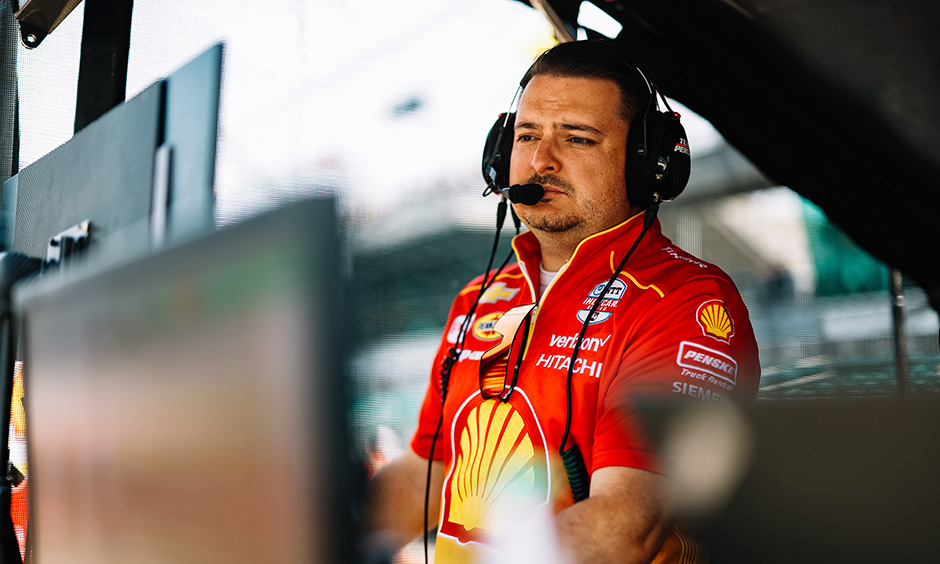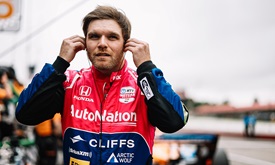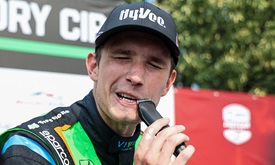The Setup: Iowa with Luke Mason
JUL 18, 2023
Note: This is a continuing series for INDYCAR.com, with different guests, leading into each race weekend for the NTT INDYCAR SERIES, focusing on various technical challenges of each respective circuit.
The only doubleheader on the schedule of 2023, Iowa Speedway will host the 11th and 12th races for the NTT INDYCAR SERIES with this weekend’s Hy-Vee Homefront 250 presented by Instacart on Saturday, followed by Sunday’s Hy-Vee One Step 250 presented by Gatorade.
The .894-mile short oval is 60 feet wide, with the frontstretch comprised of 1,075 feet and 10 degrees of banking and the backstretch banked 4 degrees while running 869 feet in length. The turns have progressive banking, which spans between 12-14 degrees.
There will be one practice session scheduled for Friday before the field for both races is set in a unique two-lap qualifying format Saturday morning, with the first lap for each driver setting the field for Race 1 and the second lap setting the field for Race 2. Both events will consist of 250 laps, with Saturday’s bout starting at 3 p.m. ET and. Sunday set for 2 p.m. ET (NBC, Peacock, INDYCAR Radio Network). Helio Castroneves holds the qualifying lap at 186.809 mph (17.2283 seconds), earned in 2014 during his second lap of a two-lap qualifying run.
This week’s featured guest is Luke Mason, race engineer for Josef Newgarden’s No. 2 Team Penske Chevrolet. Newgarden holds a record four wins at the bullring oval, including Race 1 of last year’s doubleheader with Mason as an assistant engineer.
Q: How do you prepare for a place like Iowa Speedway?
Luke Mason: I suppose even though they're all different, you generally prepare for all the ovals the same way. To be honest, the flow of the work week leading into the event doesn't really change too much either between the road and street courses. For me, I'll go through and review all last year's notes. I like to go through and rewatch all the sessions – practice, qualifying – and try to get a good feel of the event; what everyone was doing, what we did. From there, you start figuring out what your starting setup is going to be so the crew on the floor can start putting the car together. For us, fundamentally INDYCAR's short oval package hasn't changed too much in recent years. We've been fortunate that we've been really competitive at all of them, and especially Iowa, as the No. 2 team. So, for us going into Iowa, it's really about just fine-tuning the details and working within our setup window opposed to trying to reinvent the wheel.
Q: When you look at it, especially considering this event is a doubleheader, what's the general rule for setting up a car for a place like Iowa?
Mason: I think it sort of applies to all ovals, but I think a driver's confidence in their feeling of what the right rear tire is doing for me is the single most important thing. It might not look like it, but the tire is constantly sliding, and having it slide and break away in a progressive predictable way allows your drive to be more aggressive and confident in their inputs. So, because of that they can maximize the level of grip available more consistently and generate a lap time out of it. That's the real key there is sort of what the right rear tire is doing and the driver's confidence level in being able to feel what it's doing.
Q: Just because that place is bumpy and never been repaved, which the added character the track has is a good thing, in my opinion, have you noticed any significant changes with ride heights or how soft you have to go with the dampers and things like that?
Mason: Generally speaking, it's always been pretty bumpy. I don't think since we've been there, it was ever super smooth to begin with. And I'm with you, I think the more character, the more bumpier, the more tires wear out and degradations higher, the more, more exciting the racing is. Hopefully, they will never repave that place. In terms of ride heights, setup direction and trying to get over the bumps and work with the bumps, I think it's always been pretty bad. For us, the trend is sort of the same. It's not as if it's gotten worse, and we've had to react.
Q: With Iowa, like when you're trying to go out there and generate grip for the car, because the track is so short, is it more mechanical grip-dependent than aerodynamic grip-dependent, or is it neutral on both?
Mason: It's still definitely a compromise. It's not as if you prioritize one dramatically over the other. You always try to achieve some level of consistent aero platform on all the ovals and give the driver a level of support so they can lean on the car and attack the car on entry. But you're right, the bumps at Iowa, more so than anywhere else we go to, there is a compromise. Generally speaking, you are a lot softer there, it's trying to get the car to ride the bumps and not be upset by the bumps at the same time. Then, trying to give them something to lean on at the same time, it's a very difficult exercise and in how you set up the car.
Q: Is there a notorious trouble spot at Iowa?
Mason: Generally, Turn(s) 3 and 4 is a little bit more difficult. There are some really big bumps in the middle of 3 and 4, and it's very line dependent, as well. To say that you prioritize one end or the other, especially in the races, you have to move around so much to get through traffic and maintain a level of lap speed. So, you need the thing to work everywhere. You can't really afford to give up one end for the other because you can't afford to sit and wait to get through traffic in one corner. Otherwise, someone's going around you.
Q: Is there a difference between how you set up qualifying versus how you need the car to evolve to get the balance right for an entire stint?
Mason: Well, last year the rules dictated that it was impound qualifying, so it is a massive compromise because in that instance you can't run the car exactly how you want to maximize the two flying laps and then be perfect over a race stint when you have the weight of full tanks of fuel. The speeds are just so much higher in qualifying than the race pace, especially as you get deeper into stints. Obviously, the car doesn't travel and compress as much, so your ride heights are a lot higher. So, you'll see some people in that instance under the impound rules will sacrifice the race car slightly to try gain track position in qualifying at the start, while you might see others that will ultimately sacrifice some lap speed in qualifying to ensure that the car is strong over a whole stint.
For me, balance consistency over a stint is very important there. You just can't have a car destroy the right front tire, which will create too much understeer and the driver can't get back to the throttle. At the same time, you can't hurt the right rear because then that just kills the driver's confidence on corner entry, and they can't carry the speed in corner. It's a very fine balancing act of what you're trying to do and manipulate the setup to ensure that you've got a consistent car over a stint. And along with that, you need to make sure that you know all your tools that we have available to us: weight jacker and anti-roll bars that are all in a window where the driver can keep up with balance shifts and try to keep the car in the window as the lap time degrades and the tires fall off.
Q: What is the biggest key component for having a car capable of contending for the race win at Iowa?
Mason: It sort of touches on the earlier points. The first thing is making sure the driver is confident in what they've got. I think that's the biggest thing. For us and for me, especially in my position, is that Josef has been so good there historically his whole career, doesn't matter if he was in an ECR (Ed Carpenter Racing) car or a Team Penske car, him understanding what he wants from the car, what he needs it to do, how he needs it to react makes my job really easy because I can just lean on him during practice, and he can lead the direction of what we need to optimize to match the track's grip level. And this year, if there's any differences between the 2023 tire to the 2022 tire, it's a very fine line of that keeping the car in it in its balance window and not wearing out, wearing out a tire aggressively, whether it's a front or a rear, you know, once, once the tire goes and loses its grip in a certain direction, you just never get that back, and that's when you become a sitting duck. You see in the races people who get it right and start charging through the field because they've got a very nicely balanced car and looked after its tires, and you see the others that bolt for 10 laps and then all of a sudden, they're screaming on the radio, and they go two laps down after 50 laps.
Q: Track temperatures are an important variable everywhere we go, but do you find it being more crucial at a place like Iowa than others?
Mason: I mean, you're right in that track temperature makes a difference everywhere, but that that surface and how it reacts with the tire to create the degradation, I don't think it's overly temperature-sensitive. What you'll see is the day races, the ultimate lap speed is slower, and the degradation might be a little bit higher. You know, if you compare that to a night race where you might find that the average speed of the race is faster and the degradation might be slightly lower, but it's not dramatically different where it changes the way the race ultimately pans out. It doesn't grip up and the degradation isn't low enough to where you see guys do full fuel stints. You're still tire limited, and you'll still see people pit on tire strategy opposed to being a fuel strategy race. So, I would say that the temperature of the track itself is probably less important at Iowa than other places.
Q: Each driver has a different style of preferred setup. Obviously, a neutral balance would be great, but it is so tough to find. When it comes to Josef, what have you noticed about him in your short time as his race engineer in his preference toward understeer versus oversteer, and what makes him so good at Iowa?
Mason: In terms of, of balance, I don't think it's really one way or the other or as cut and dry as that. He needs, like any driver, confidence that the right rear of the car is going to be there and have that stability on corner entry and having that allows him to be aggressive on the wheel. Generally, his inputs are quite aggressive. For us, we start there and make sure that the car is secure on the way in. Then at the same time, you can't just make it super stable because then it doesn't turn. So, we start there and then start making sure we've got enough turn in the car so he can drive both ways. Generally, you want it to be a little loose for ultimate lap time, but at the same time, it's not the nicest, most consistent way to drive a car. We'd like to keep it fairly neutral and have him be able to adjust the balance for what he needs with the tools in the car.




















